When the statement “It’s just like BPR from twenty years ago, but with tech that actually works” rang out at the recent London FORA Summit, the nods around the room were palpable.
2017 has undoubtedly been the break-out year for enterprise robotics software. We witnessed a whole new industry emerge around robotic technologies that can stitch together workflows, processes, applications and desktop interfaces to provide a genuine transformation of the digital underbelly for so many enterprises, many of whom have suffered for decades from inefficient manual workarounds and spaghetti code clogging up their ability to access data and run their businesses properly. Today, the emerging solutions available on the market do not load the enterprise transformation blunderbuss with silver bullets, but they do provide a starting point to improve fundamentally the data underbelly of an organization. And, for so many organizations, they are turning to robotics software RPA (Robotic Process Automation) and RDA (Robotic Desktop Automation) as the starting point.
Robotic Process Automation
The global market for RPA Software and Services will reach $898 million in 2018 and is expected to grow to $2.2 billion by 2021 at a compound annual growth rate of 54%.
RPA Definition:
Example use-case: automating invoice processing across multiple business applications handling rule-based exceptions. RPA is different from traditional automation software as it is inherently capable of recognizing and adapting to deviations in data or exceptions when confronted by large volumes of data. In effect, it can be intelligently trained to analyze large amounts of data from software processes and translate them to triggers for new actions, responses, and communication with other systems. RPA describes a software development toolkit that allows non-engineers to quickly create software robots (known commonly as “bots”) to automate rules-driven business processes. At the core, an RPA system imitates human interventions that interact with internal IT systems. It is a non-invasive application that requires minimum integration with the existing IT setup; delivering productivity by replacing human effort to complete the task. Any company which has labor-intensive processes, where people are performing high-volume, highly transactional process functions, will boost their capabilities and save money and time with robotic process automation. Much fr RPA is self-triggered (bots pass tasks to humans), but requires human intervention for judgment-intensive tasks and robust human governance and to make changes / improvements.
Similarly, RPA offers enough advantage to companies which operate with very few people or shortage of labor. Both situations offer a welcome opportunity to save on cost as well as streamline the resource allocation by deploying automation. The direct services market includes implementation and consulting services focused on building RPA capabilities within an organization. It does not include wider operational services like BPO, which may include RPA becoming increasingly embedded in its delivery.
Robotic Desktop Automation
In addition to RPA, the other software toolset which comprises the emergence of enterprise robotics software is termed RDA (Robotic Desktop Automation). Together with RPA, RDA will help drive the market for enterprise robotic software towards $1.5bn in software and services expenditure in 2018 (with close to three-quarters tied to the services element of strategy, design, transformation and implementation of enterprise robotics). HfS’ new estimates are for the total enterprise robotics software and services market to surpass $3 billion by 2021 as a compound growth rate of 39%.
RDA Definition:
Example use-case: automating transfer of data from one system to another. RDA is essentially surface automation, where desktop screens (whether desktop-based, web-based, cloud-based) are “scraped”, scripted and re-programmed to create the automation of data across systems. A well-designed RDA solution can automate workflows on several levels, specifically: application layer; storage layer; OS layer and network layer. Workflow automation on these layers requires equally specific technologies but provides advantages of efficiency, reliability, performance and responsiveness. Much of this automation needs to be attended by humans as the automation is triggered by humans (humans pass tasks to bots), as data inputs are not always predictable or uniform, but adaptation of smart Machine Learning techniques can reduce the amount of human attendance over time and improve the intelligence of these automated processes. Similarly to RPA, RDA requires human intervention for judgment-intensive tasks and robust human governance and to make changes / improvements:
The Bottom-Line: Automation and AI have a significant part to play in engineering a touchless and intelligent OneOffice
However which way we spin “digital”, the name of the game is about enterprises responding to customer needs as and when they occur, and these customers are increasingly wanting to interact with companies without physical interaction. This means manual interventions must be eliminated, data sets converged and process chains broadened and digitized to cater for the customer. This means entire supply chains need to be designed to meet these outcomes and engage with all the stakeholders to service customers seamlessly and effectively. There is no silver bullet to achieve this, but there is emerging technology available to design processes faster, cheaper and smarter with desired outcomes in mind. The concept was pretty much the same with business process reengineering two+ decades ago, but the difference today is we have emerging tech available to do the real data engineering that is necessary:
In short, every siloed dataset restricts the analytical insight that makes process owners strategic contributors to the business. You can’t create value – or transform a business operation – without converged, real-time data. Digitally-driven organizations must create a Digital Underbelly to support the front office by automating manual processes, digitizing manual documents to create converged datasets, and embracing the cloud in a way that enables genuine scalability and security for a digital organization. Organizations simply cannot be effective with a digital strategy without automating processes intelligently – forget all the hype around robotics and jobs going away, this is about making processes run digitally so smart organizations can grow their digital businesses and create new work and opportunities. This is where RPA and RDA adds most value today… however, as more processes become digitized, the more value we can glean from cognitive applications that feed off data patterns to help orchestrate more intelligent, broader process chains that link the front to the back office. In our view, as these solutions mature, we’ll see a real convergence of analytics, RPA and cognitive solutions as intelligent data orchestration becomes the true lifeblood – and currency – for organizations.
Do take some time to read the HfS Trifecta to understand the real enmeshing of automation, analytics and AI.
Posted in : OneOffice, Robotic Process Automation


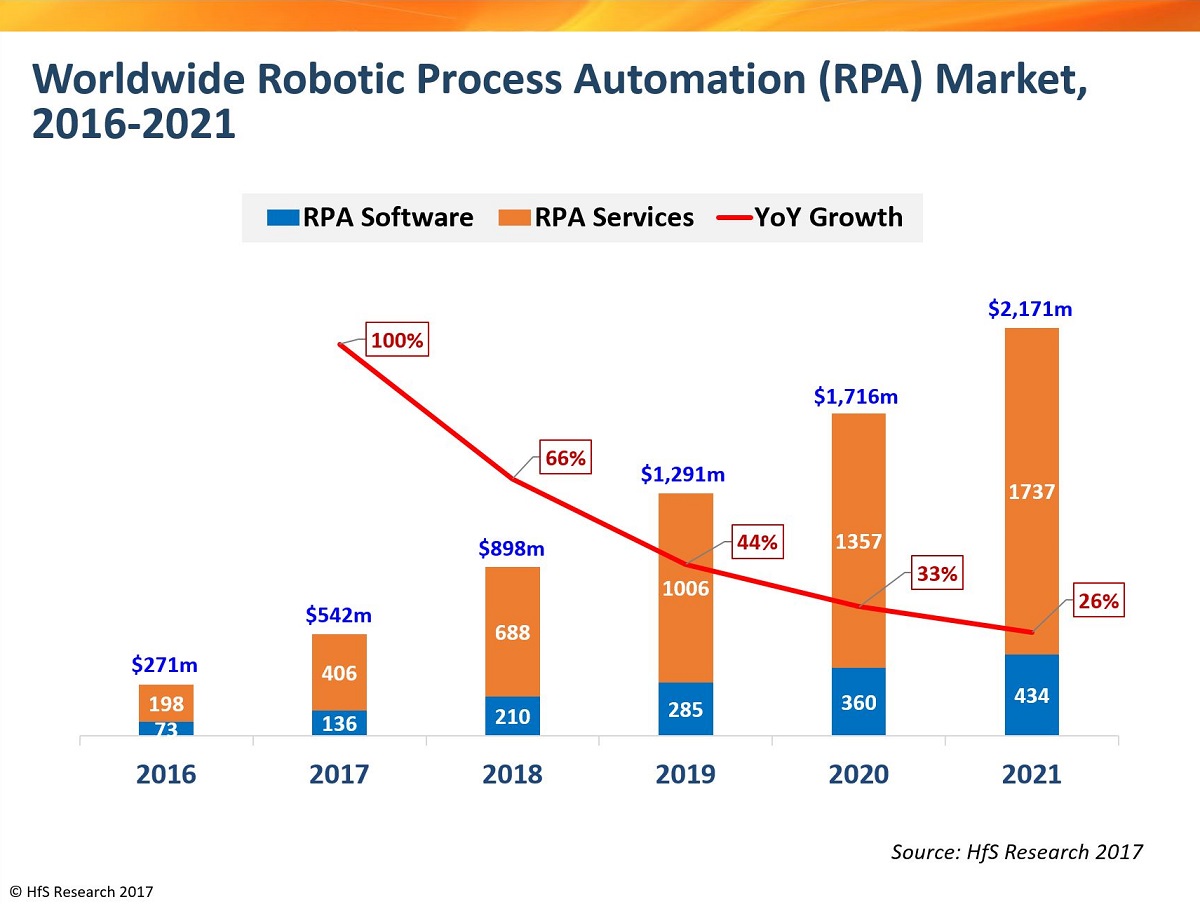
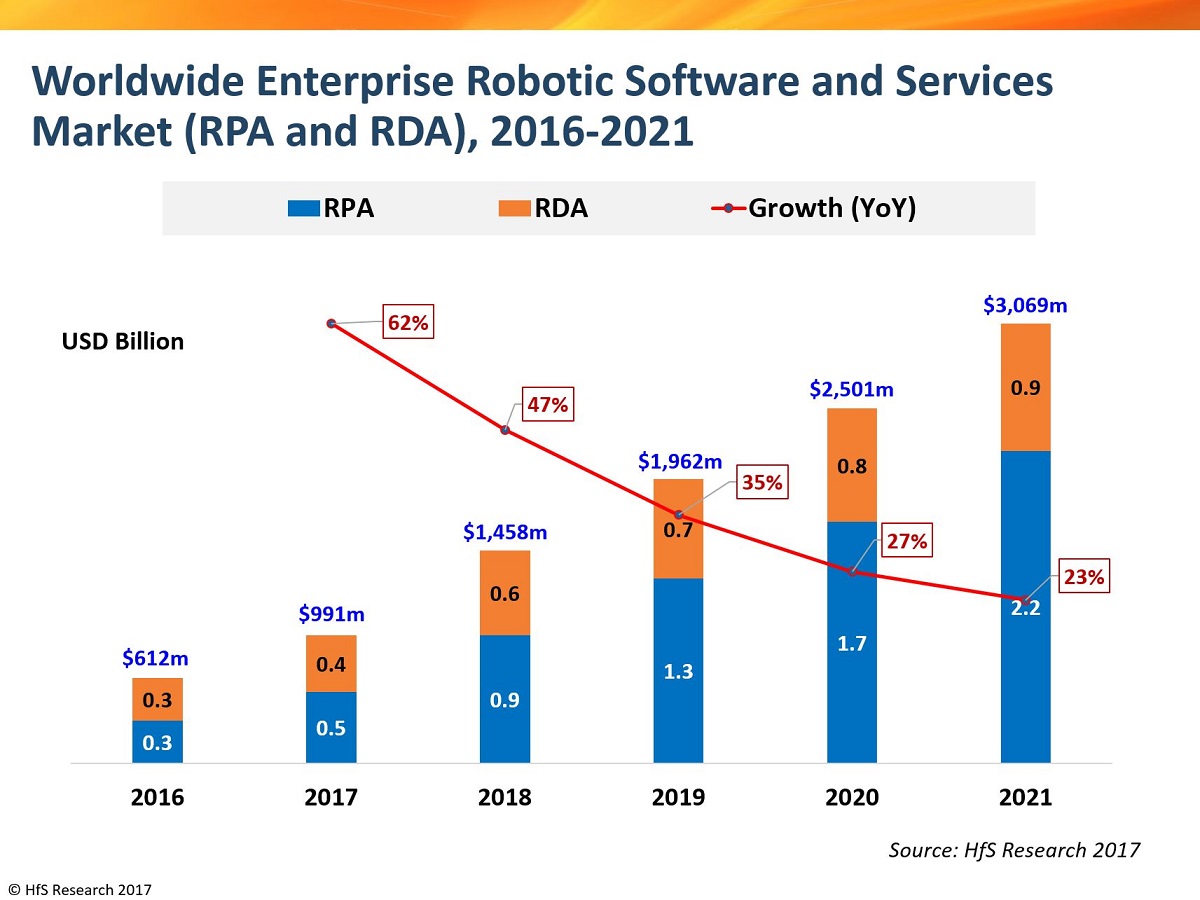
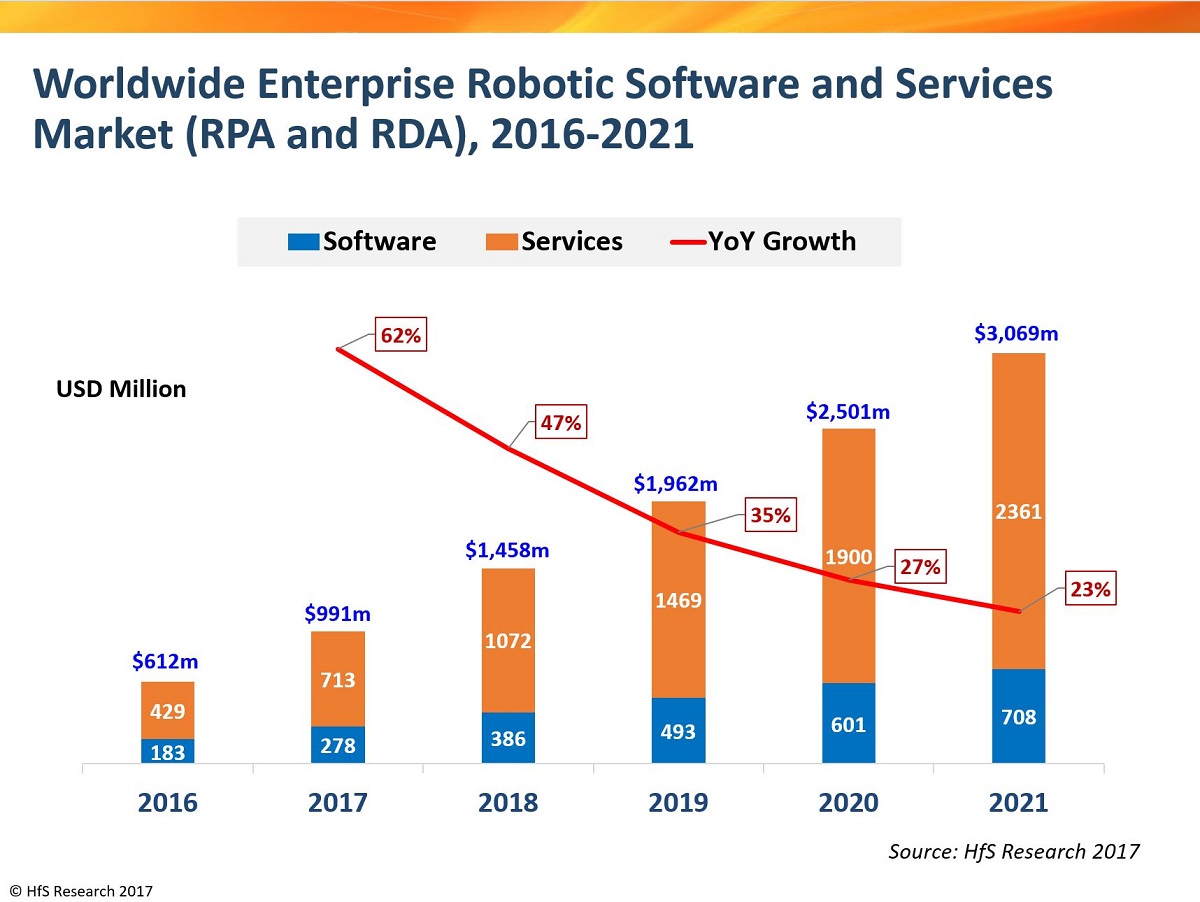
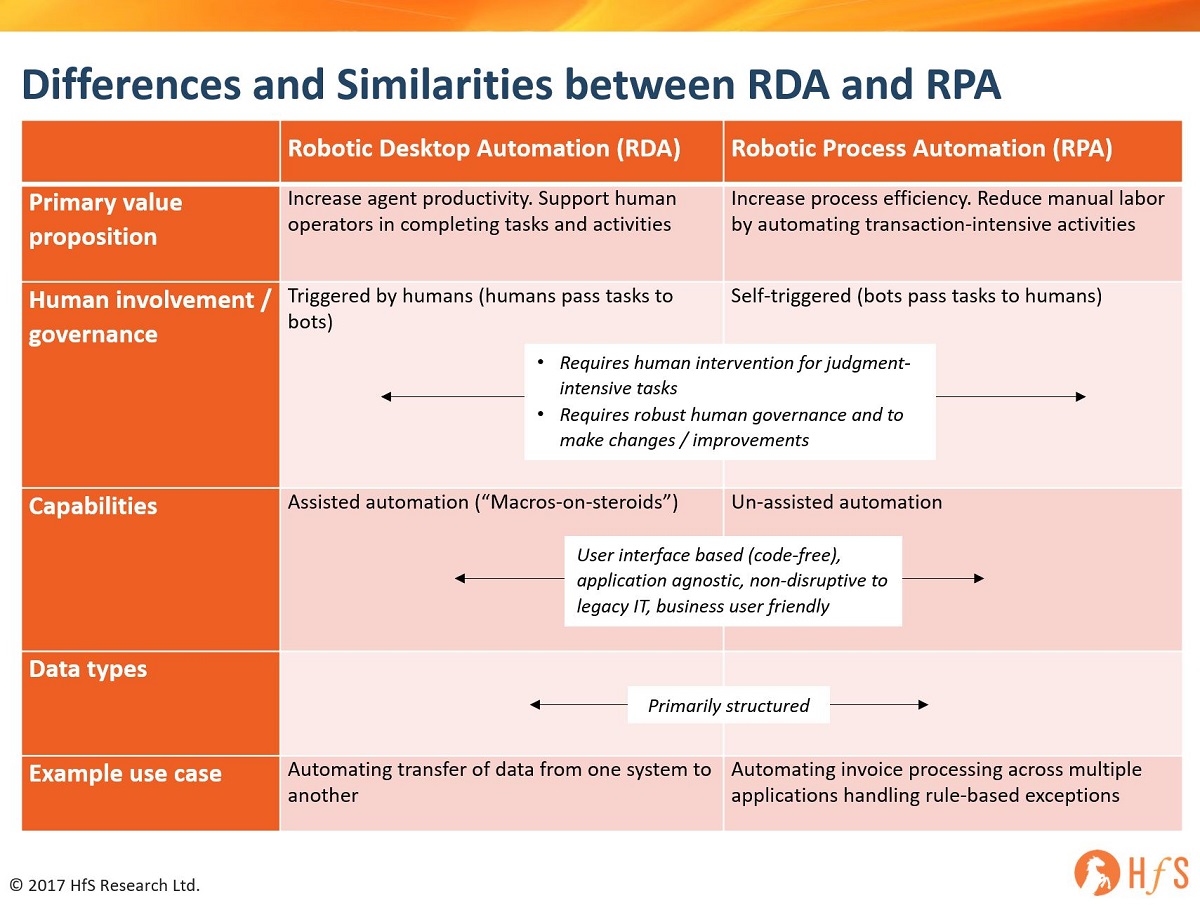
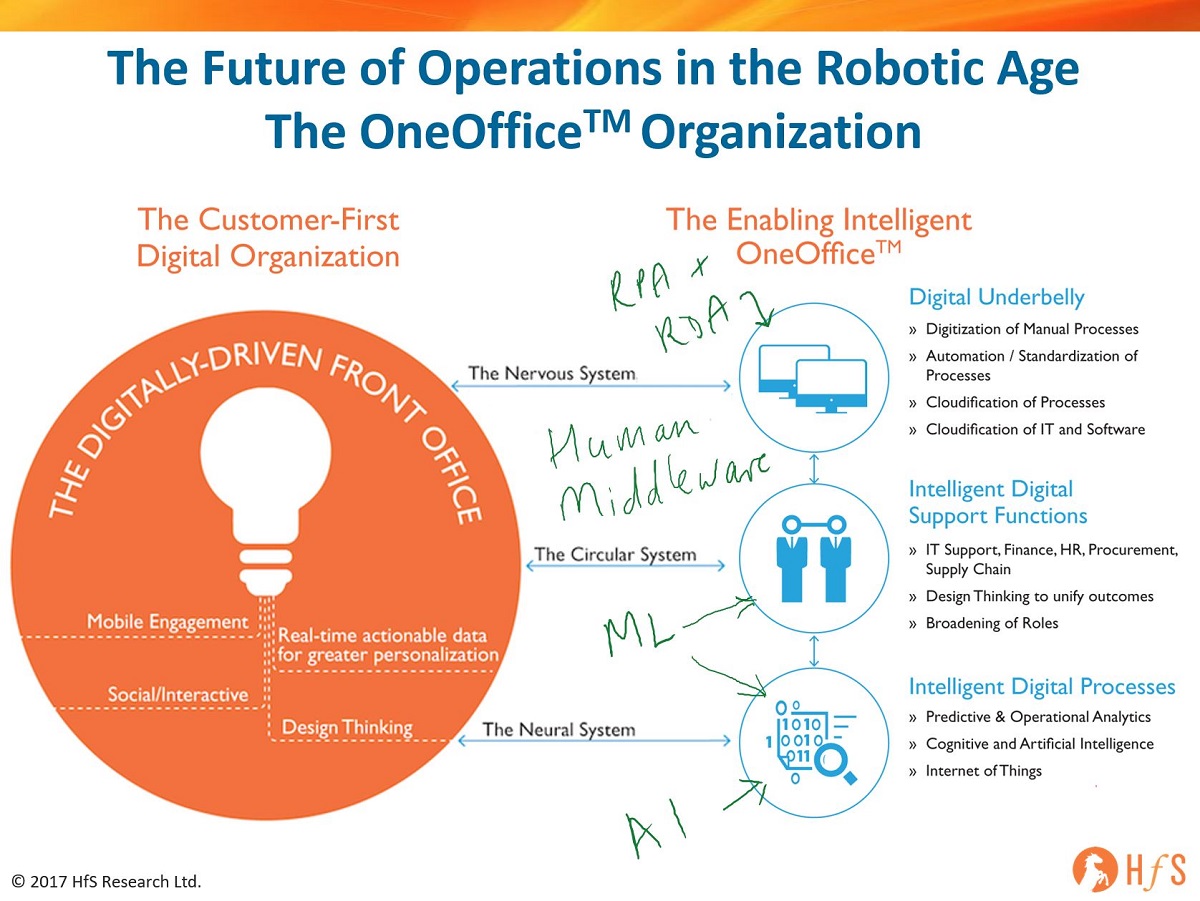




Phil,
Thank you for sharing such an informed market view. This is very useful,
David
Phil,
Thank you for breaking out RDA and RPA as too many supplers are blurring the two. Interesting how the services portion is dwarfing the software spend,
Joseph Dunn
Great work, Phil and HFS! These numbers seem very realistic,
Sandeep
Phil, This really is a great insight. This is very near to reality and in stark contrast to few others that report numbers with many inaccurate assumptions.
Thanks and keep sharing the great content .
On A side note, please do give me a shout when you plan to visit this side of the ocean “Dublin”
Best
Ritesh
Ritesh
Thanks Phil. Those were great insights. Particularly the data on services exceeding the software spends by almost 3 times. Currently I am involved in driving an RPA program in the wealth management space. The processes, applications and data points have been unique and we are sucessfully automating using Blue Prism
Phil as a pre-cursor to RPA/Automation shoud’nt orgainzations re-engineer process( BPM) .We find a lot of organizations trying to implement RPA either through an organization re-structuring or before it leading to implementation failures- what is your take on this ?